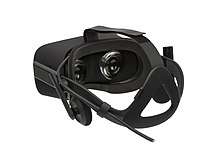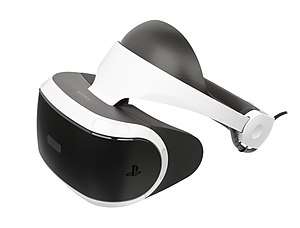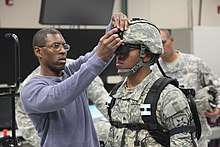Virtual reality headset

A virtual reality headset is a head-mounted device that provides virtual reality for the wearer. VR headsets are widely used with computer games but they are also used in other applications, including simulators and trainers. They comprise a stereoscopic head-mounted display (providing separate images for each eye), stereo sound, and head motion tracking sensors[1] (which may include gyroscopes, accelerometers, structured light systems,[2] etc.). Some VR headsets also have eye tracking sensors[3] and gaming controllers.
History
.jpg)
The Sega VR, announced in 1991 and seen in early 1993 at the Winter CES, was never released.[4] An early VR headset, the Forte VFX1, was announced at CES in 1994. The VFX-1 has stereoscopic displays, 3-axis head-tracking, and stereo headphones.[5] Sony, another pioneer, released the Glasstron in 1997, which has an optional positional sensor, allowing the wearer to view the surroundings, with the perspective moving as his head moves, giving a deep sense of immersion. These VR headsets gave MechWarrior 2 players a new visual perspective of seeing the battlefield from inside the cockpit of their craft. However, these early headsets failed commercially due to their limited technology[6][7] and were described by John Carmack as like "looking through toilet paper tubes".[8]
In 2012, a crowdfunding campaign began for a VR headset known as Oculus Rift; the project was led by several prominent video game developers, including John Carmack[6] who later became the company's CTO.[9] In March 2014, the project's parent company Oculus VR was acquired by Facebook for US$2 billion.[10] The final consumer-oriented release of Oculus Rift began shipping on 28 March 2016.[11]
In March 2014, Sony demonstrated a prototype headset for PlayStation 4,[12] which was later named PlayStation VR.[13] In 2014, Valve Corporation demonstrated some headset prototypes,[14] which lead to a partnership with HTC to produce the Vive, which focuses on "room scale" VR environments that users can naturally navigate within and interact with.[15] The Vive was released in April 2016[16] and PlayStation VR in October 2016.[17]

Virtual reality headsets and viewers have also been designed for smartphones. Unlike headsets with integrated displays, these units are essentially enclosures which a smartphone can be inserted into. VR content is viewed from the screen of the device itself through lenses acting as a stereoscope, rather than using dedicated internal displays. Google released a series of specifications and associated DIY kits for virtual reality viewers known as Google Cardboard; these viewers are capable of being constructed using low-cost materials, such as cardboard (hence the naming).
Samsung Electronics partnered with Oculus VR to co-develop the Samsung Gear VR (which is only compatible with recent Samsung Galaxy devices), while LG Electronics developed a headset with dedicated displays for its LG G5 smartphone known as LG 360 VR.[18][19][20][21]
Asian hardware manufacturers like Xion and Kolke have developed inexpensive virtual reality headsets. In late April 2017, the Chinese company Tencent announced it was preparing to launch its virtual reality headset that year.[22]
Constraints
Latency requirements
Virtual reality headsets have significantly higher requirements for latency—the time it takes from a change in input to have a visual effect—than ordinary video games.[23] If the system is too sluggish to react to head movement, then it can cause the user to experience virtual reality sickness, a kind of motion sickness.[24] According to a Valve engineer, the ideal latency would be 7-15 milliseconds.[25] A major component of this latency is the refresh rate of the display,[24] which has driven the adoption of displays with a refresh rate from 90 Hz (Oculus Rift and HTC Vive) to 120 Hz (PlayStation VR).[26]
The graphics processing unit (GPU) also needs to be more powerful to render frames more frequently. Oculus cited the limited processing power of Xbox One and PlayStation 4 as the reason why they are targeting the PC gaming market with their first devices.[27]
Resolution and display quality
Because virtual reality headsets stretch a single display across a wide field of view (up to 110° for some devices according to manufacturers), the magnification factor makes flaws in display technology much more apparent. One issue is the so-called screen-door effect, where the gaps between rows and columns of pixels become visible, kind of like looking through a screen door.[28] This was especially noticeable in earlier prototypes and development kits,[7] which had lower resolutions than the retail versions.
Lenses
The lenses of the headset are responsible for mapping the up-close display to a wide field of view,[29][30] while also providing a more comfortable distant point of focus. One challenge with this is providing consistency of focus: because eyes are free to turn within the headset, it's important to avoid having to refocus to prevent eye strain.[31]
The lenses introduce distortion and chromatic aberration, which are typically corrected in software.[29]
The lenses can also be adjusted dynamically to account for a user's eyeglass prescription, so that the user can use the headset without corrective eyeglasses.[32]
Uses in various fields
Medical training

Virtual reality headsets are being currently used as a means to train medical students for surgery. It allows them to perform essential procedures in a virtual, controlled environment. Students perform surgeries on virtual patients, which allows them to acquire the skills needed to perform surgeries on real patients.[33] It also allows the students to revisit the surgeries from the perspective of the lead surgeon.[34]
Traditionally, students had to participate in surgeries and often they would miss essential parts. Now, with the use of VR headsets, students can watch surgical procedures from the perspective of the lead surgeon without missing essential parts. Students can also pause, rewind, and fast forward surgeries. They also can perfect their techniques in a real-time simulation in a risk free environment. [34]
Military training
Virtual reality headsets have been used for training United States soldiers of the army, air-force, and navy.[35] It is a particularly useful tool for training soldiers without putting them in harm's way.[36]
See also
References
- ↑ Ben Kuchera (15 January 2016). "The complete guide to virtual reality in 2016 (so far)". Polygon.
- ↑ Adi Robertson. "The ultimate VR headset buyer's guide". TheVerge.com. Vox Media.
- ↑ Stuart Miles (19 May 2015). "Forget head tracking on Oculus Rift, Fove VR headset can track your eyes". Pocket-lint.
- ↑ Vinciguerra, Robert. "Tom Kalinske Talks About His Time Overseeing Sega As Its CEO In the 90s; Reveals That Sega Passed On Virtual Boy Technology, Considered Releasing 3DO". The Rev. Rob Times. Retrieved 21 September 2015.
- ↑ Nathan Cochrane (1994). "VFX-1 VIRTUAL REALITY HELMET by Forte". Game Bytes Magazine.
- 1 2 "Oculus Rift virtual reality headset gets Kickstarter cash". BBC News. 1 August 2012.
- 1 2 Greg Kumparak (26 March 2014). "A Brief History Of Oculus". TechCrunch.
- ↑ Charles Onyett (3 August 2012). "The Future of Gaming in Virtual Reality". IGN.
- ↑ Alex Wilhelm (22 November 2013). "Doom's John Carmack Leaves id Software To Focus On The Oculus Virtual Reality Headset". TechCrunch.
- ↑ Welch, Chris (March 25, 2014). "Facebook buying Oculus VR for $2 billion". The Verge. Retrieved March 26, 2014.
- ↑ "Oculus apologizes for shipping delays, will waive shipping fees for all orders to date". The Verge. Retrieved 30 July 2016.
- ↑ Michael McWhertor (18 March 2014). "Sony announces Project Morpheus, a virtual reality headset coming to PlayStation 4". Polygon.
- ↑ Aaron Souppouris (15 September 2015). "Sony's Project Morpheus is now 'PlayStation VR'". Engadget.
- ↑ Tom Warren (3 June 2014). "Valve's VR headset revealed with Oculus-like features". The Verge.
- ↑ Dante D'Orazio, Vlad Savov (1 March 2015). "Valve's VR headset is called the Vive and it's made by HTC". The Verge.
- ↑ Adi Robertson (8 December 2015). "HTC Vive VR headset delayed until April". The Verge.
- ↑ "PlayStation VR Launches October 2016". Sony. Archived from the original on 22 July 2016. Retrieved 15 March 2016.
- ↑ "LG's G5 is a radical reinvention of the flagship Android smartphone". The Verge. Retrieved 21 February 2016.
- ↑ "IFA 2014: Samsung Galaxy Note 4, Note Edge, Gear VR and Gear S hands-on". GSMArena.com. Retrieved 2015-11-24.
- ↑ "You Can Now Watch and Upload 360-Degree Videos on YouTube". Wired. Retrieved 12 July 2016.
- ↑ "Best VR headsets to buy in 2016, whatever your budget". Pocket-lint. Retrieved 12 July 2016.
- ↑ Bradshaw, Tim (April 30, 2017). "Tencent poised to launch virtual reality headset". Financial Times. Retrieved April 30, 2017.
- ↑ Ben Lang (24 February 2013). "John Carmack Talks Virtual Reality Latency Mitigation Strategies". Road to VR.
- 1 2 "Virtual reality developers struggle with motion sickness". news.com.au. 21 March 2016.
- ↑ Kyle Orland (4 January 2013). "How fast does "virtual reality" have to be to look like "actual reality"?". Ars Technica.
- ↑ Leo Kelion (4 March 2015). "Sony's Morpheus virtual reality helmet set for 2016 launch". BBC News.
- ↑ Eddie Makuch (13 November 2013). "Xbox One, PS4 "too limited" for Oculus Rift, says creator". GameSpot.
- ↑ "Screen-Door Effect: PlayStationVR Supposedly Has "None", Probably Doesn't Matter". Talk Amongst Yourselves (Kinja). 27 March 2016.
- 1 2 Paul James (21 October 2013). "Intel Claims It Can Improve Image Quality for HMDs — Daniel Pohl Tells Us How". Road to VR.
- ↑ Ben Lang (13 May 2015). "Wearality's 150 Degree Lenses Are a Balancing Act, Not a Breakthrough". Road to VR.
- ↑ Matthew Terndrup (6 October 2015). "Palmer Luckey talks advantages of the Rift's custom lenses". UploadVR.
- ↑ Laffont, Pierre-Yves; Martin, Tobias; Gross, Martin; Tan, Wei De; Lim, CT; Au, Affa; Wong, Rick (December 5–8, 2016). "Rectifeye: A Vision-Correcting System for Virtual Reality". Macau. doi:10.1145/2996376.2996382. No. 13. Missing or empty
|url=(help) Qute: "our system automatically adjusts the VR headset according to the user’s eyeglasses prescription. Since the optical correction is automatically embedded into the headset, the user no longer needs to wear eyeglasses inside the headset. [...] We adjust the position of each lens in the headset with servomotors". - ↑ "Advantages of virtual reality in medicine - Virtual Reality". Virtual Reality. Retrieved 2016-04-12.
- 1 2 Rousseau, Rémi (2014-08-13). "Virtual surgery gets real: What the Oculus Rift could mean for the future of medicine". Medium. Retrieved 2016-04-12.
- ↑ "Virtual Reality in the Military - Virtual Reality Society". Virtual Reality Society. 2017-05-05. Retrieved 2018-04-09.
- ↑ "How VR is training the perfect soldier". Wareable. Retrieved 2018-04-09.